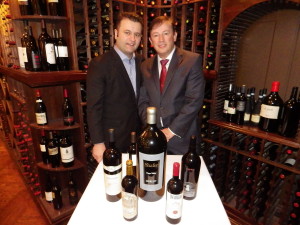Expansion seared to perfection
Frequently filled with business executives and out-of-towners, Benjamin Steakhouse in White Plains is known for its dining experience, its 500-plus wine selections and its prime meat choices ranging from rib-eye steak and rack of lamb to filet mignon and New York strip. After three years of operating mostly as a destination restaurant, Benjamin Steakhouse owners Benjamin Prelvukaj and Benjamin Sinanaj plan to open a Benjamin Grill next door in January to attract more of its Westchester-based customers, creating a new menu using the same meat cuts, but featuring less heavy dinner portions.
“We want everyone to come here and get a taste of our meat,” said Sinanaj. “We hope to attract more neighbors in the area with more affordable meals on our dinner menu.”
The 1,500-square-foot grill will serve as a lounge and casual dining venue for everyday customers. Instead of getting a dry-aged Porterhouse steak for four, customers can order a prime rib sandwich and a steak salad on the side. With the idea of popularizing an otherwise expensive dining experience, Prelvukaj and his brother-in-law Sinanaj still have the luxury of serving the same fresh meat cooked by chef Arturo McLeod from the famed Peter Luger”™s in Brooklyn.

Montenegro natives Prelvukaj and Sinanaj first opened Benjamin Steakhouse in Manhattan seven years ago and expanded to its White Plains location at 610 West Hartsdale Avenue in 2010. The White Plains-based Benjamin Steakhouse opens only during dinner time from Tuesday through Saturday and during lunch and dinner on Sundays. Although the restaurant opened for lunch the first year, the owners realized not many customers have extended lunch breaks to come and eat steak and drink wine, so they made an executive decision to get rid of power lunches and shifted to power dinners.
“We are known as the restaurant for power dinners, especially in the corporate world,” Prelvukaj said. “Companies choose steakhouses to do business because everything is very straight forward. The quality of food and service is always great. One thing you don”™t want to worry about when you”™re going to dinner is the quality of food. A lot of times, the restaurant is the deal breaker for clients because things can go wrong: the food is late, a waiter spills something on customers or the line is too long.”
By opening later, Benjamin Steakhouse owners still host at least two corporate dinner meetings a night.
“During the week, we do a lot of corporate dinners,” Prelvukaj said. “You hear tables with lawyers talking about their deals and lawsuits, you have hedge fund operators trying to predict the market on a daily basis, and you have CPA firms talking about audits and the IRS. Meanwhile, you have people from the neighborhood talking about Obamacare.”
With a diverse spectrum of dinner conversations framed by an economy turning around, Prelvukaj said his business has successfully been selling higher quality wines now compared with what it sold when it first opened.
“The way we measure how the economy is doing is by what kind of bottles of wine people buy,” Prelvukaj said. “The cheapest bottle we sell is $40 and the most expensive is $4,000. When we first opened, the average price corporations paid for a bottle of wine during dinner was around $65 to $70. Now the average bottle of wine during the week is $100 to $120 and sometimes up to $200. People have bigger budgets since the economy is doing better. Companies are comfortable spending money to entertain their clients and conduct deals.”
Prelvukaj, who worked as a waiter at Peter Luger”™s for four years, entertained the idea of running a steakhouse business because the menu was fairly simple.
“I saw big potential in the steakhouse business because it”™s more straightforward than any other restaurants,” Prelvukaj said. “Italian restaurants can have so many different sauces and a complicated menu. But for steakhouses, the main thing is buying good quality beef and having a chef who can cook it properly.”
Prelvukaj and Sinanaj, who moved to Ardsley where they currently live in 2005, frequently took their children to Mighty Joe Young”™s, the restaurant that predated Benjamin Steakhouse. The Benjamin Steakhouse owners as frequent customers established a relationship with the owners of Mighty Joe Young”™s over time. Eventually, the owners sold the property that used to be a rundown American grill to Prelvukaj and Sinanaj, who invested $2 million to gut the 15,000-square-foot space and purchase handmade grills that fired up to 1,600 degrees Fahrenheit to cook quality steak, similar to the method used at Peter Luger”™s.
Sinanaj said he and McLeod travel to Hunts Point Cooperative Market in the Bronx at 5 a.m. every week to purchase the meat; then it is dry-aged for at least 28 days, which he said is enough time to “break the tissue and let the meat become tender.”
For corporate dinners, the steakhouse venue includes roundtables that seats between eight and 10 people per table in all four corners, providing privacy and a more intimate gathering space, Prelvukaj said. And not everyone has to order a steak dinner, especially when clients are in the process of closing a heavy deal, he said. In the past, the chefs have cooked something as simple and light as chicken pasta upon request.